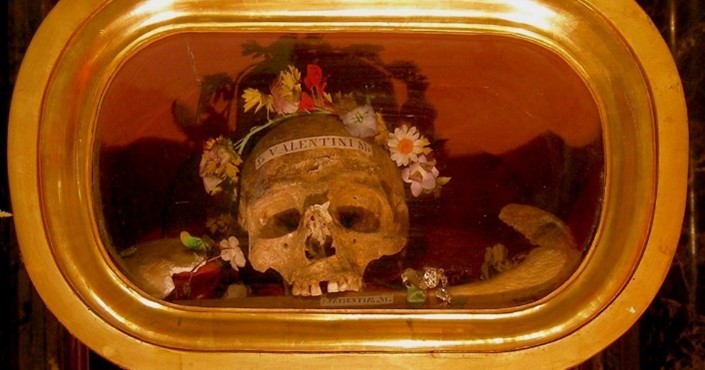A VALENTINE AMONG THE ASHES

The purported skull of Saint Valentine,
Basilica of Santa Maria in Cosmedin, Rome
This year, Ash Wednesday falls on Valentine’s Day, one of only three times this century it lands on February 14: 2018, 2024, and 2029. A quick Google search reveals that this poses a serious dilemma for Roman Catholics—what to do when February 14 is both a feast day and a day of holy obligation when one is supposed to fast? Answer: Fast wins over feast and bishops are directing their flocks to celebrate the Feast of Saint Valentine a day early on Mardi Gras. Protestants have it much easier—they have no rule against dropping in to church for an Ash Wednesday service before heading off to a romantic restaurant for dinner.
While at first glance the juxtaposition of pink and red cards proclaiming “I love you” alongside a ritual in which you receive ashes on your forehead in the shape of a cross and hear your pastor remind you, “Remember you are dust and to dust you shall return” seems inappropriate, a second glance might reveal they’re more connected than you think…
February 14, 269 CE, is the date Valentine, a priest or bishop in Rome (no one’s exactly sure which), was beheaded by the Emperor Claudius II. Two hundred years after he was martyred, February 14 was named a feast day by the Church. But the original feast only commemorated his martyrdom and had nothing to do with romance.
When did the feast for a 3rd century Roman bishop who was decapitated turn into a day of roses, chocolate, hearts, and romantic cards? Not until the Middle Ages, when a poem by Geoffrey Chaucer, The Parliament of Fowls linked the early signs of spring with romance, affirming a popular belief that in mid-February, birds chose their mates. It was also during the Middle Ages that Valentine was named the patron saint of people in love (as well as people with epilepsy and beekeepers!).
After his death, legend has it that Valentine’s bones were divided up and sent to churches all over Europe to serve as holy relics displayed for veneration. In fact, so many of “his” bones appeared in various places that they could have been assembled into at least three complete skeletons.
One of the skulls came to rest in the city where Valentine was executed, Rome, and for centuries has been housed in a basilica made famous by the movie Roman Holiday featuring Audrey Hepburn gingerly placing her hand inside the “Mouth of Truth” sculpture on the church’s outer wall. That sculpture has nothing to do with Saint Valentine, but just feet away, inside the church, is a gold reliquary with a glass front that is said to contain Valentine’s skull, crowned in flowers, with a strip of paper across the forehead that says “Valentine.”
Skulls were, apparently, a big hit with medieval Christians. Not only did they undertake pilgrimages to visit and venerate relics like Valentine’s skull, monks and priests often kept a skull on their desk, a memento mori (Latin for “remember you will die). It served as a daily reminder of the inevitability of death.

“Saint Jerome in His Study” by Caravaggio, Valletta
During the Renaissance they called this the problem of decay, the decay not just of objects but of our very lives. Shakespeare offered a solution: “to take part in a love that is bigger than we are—the kind of love that ‘alters not,’ that ‘bears it out even to the edge of doom’—a kind of love that can only be described as divine love.” [Paul J. Willis, “What Shakespeare Taught Me About Ash Wednesday”]
Jesus came to the same conclusion: “Do not lay up for yourselves treasures on earth, where moth and rust consume…but lay up for yourselves treasures in heaven, where neither moth nor rust consumes…”
Storing up treasures in heaven involves devoting ourselves to giving and receiving God’s love—a love that is borne out even to the edge of doom. Anything else is just dust and ashes. “Ash Wednesday, with its visible sign of dust and ashes on our foreheads, is a forcible reminder of our own frailty and mortality… We don’t like to remember those parts of ourselves, but on this day, it is literally rubbed onto us. The mark of ash rubbed onto our foreheads can likewise serve as our own memento mori. But for us the mark is made in the shape of a cross… not only a reminder of our own deaths” [Willis], but also a reminder of a death that revealed God’s love is stronger than death.
So perhaps it is a happy coincidence after all that every so often Ash Wednesday falls on Valentine’s Day. Skulls and roses. Death and love that is stronger than death.

Oh…and chocolate. For God’s sake, don’t forget the chocolate.

